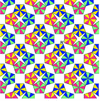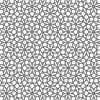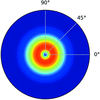issue contents
September 2019 issue

Cover illustration: Serial crystallography often records thousands of snapshot (or still) diffraction patterns from individual crystals. The program XGANDALF developed by Gevorkov et al. [Acta Cryst. (2019), A75, 694-704] rapidly and accurately indexes noisy diffraction patterns using a variant of Fourier indexing where Bragg peaks create sinusoidal densities in real space. Noise tolerance is achieved by replacing sine waves with other periodic basis functions. Smooth basis functions provide a large radius of convergence for the peak search and are then replaced by sharper functions in the later stages. The images in the background show real-space distributions that follow this progression from fast convergence to high precision.
advances
research papers
 access
accessfoundations
research papers


 access
accessaddenda and errata



 journal menu
journal menu






























